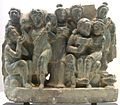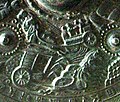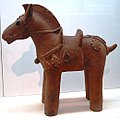Tokyo National Museum
| Tokyo National Museum | |
|---|---|
| 東京国立博物館 | |
 Honkan building |
|
| Established | 1872 |
| Location | Taito, Tokyo, Japan |
| Type | Art museum |
| Public transit access | Ueno Station |
| Website | http://www.tnm.go.jp/en/ |
Established 1872, the Tokyo National Museum (東京国立博物館 Tōkyō Kokuritsu Hakubutsukan), or TNM, is the oldest and largest museum in Japan. The museum collects, houses, and preserves a comprehensive collection of art works and archaeological objects of Asia, focusing on Japan. The museum holds over 110,000 objects, which includes 87 Japanese National Treasure holdings and 610 Important Cultural Property holdings (as of July, 2005). The museum also conducts research and organizes educational events related to its collection.
The museum is located inside Ueno Park in Taito, Tokyo. The facilities consist of the Honkan (本館, Japanese Gallery), Tōyōkan (東洋館, Asian Gallery), Hyōkeikan (表慶館), Heiseikan (平成館), Hōryū-ji Hōmotsukan (法隆寺宝物館, the Gallery of Hōryū-ji Treasures), as well as Shiryōkan (資料館, the Research and Information Center) and other facilities (Map). There are restaurants and shops within the museum's premises, as well as outdoor exhibitions and a garden where visitors can enjoy seasonal views.
The museum's collections focus on ancient Japanese art and Asian art along the Silk Road. There is also a large collection of Greco-Buddhist art.
All information is provided in Japanese, Chinese, English, French, German, Korean, and Spanish.
Contents |
[edit] History
The museum came into being in 1872, when the first exhibition was held by the Museum Department of the Ministry of Education at the Taiseiden Hall. This marked the inauguration of the first museum in Japan. Soon after the opening, the museum moved to Uchiyamashita-cho (present Uchisaiwai-cho), then in 1882 moved again to the Ueno Park, where it stands today. Since its establishment, the museum has experienced major challenges such as the Great Kanto Earthquake in 1923, and a temporary closing in 1945, during World War II. In more than the 120 years of its history, the museum has gone under much evolution and transformation through organizational reforms and administrative change.
The museum went through several name changes, being called the Imperial Museum in 1886 and the Tokyo Imperial Household Museum in 1900, until it was given its present title in 1947.
[edit] Timeline

The growth and development of today's museum has been an evolving process:
- 1872—The Ministry of Education holds the first public exhibition in Japan at the Taiseiden Hall of the former Seido at Bunkyō special ward of Tokyo; and institution is named "Museum of the Ministry of Education."[1]
- 1875—The Ministry of Interior accepts responsibility for Museum collections which are divided into eight categories: nature, agriculture & forestry, industry, fine art, history, education, law, and land & sea.[1]
- 1882—The museum was moves to its present location, a site formerly occupied by the headquarters (Hombo) of the Kan'ei-ji Temple in Ueno.[1]
- 1889—The Imperial Household Ministry accepts control of Museum collections; and institution is renamed the "Imperial Museum."[1]
- 1900—The museum is renamed is renamed "Tokyo Imperial Household Museum."[1]
- 1923—The museum's main building ( Honkan) is damaged in the Great Kantō Earthquake of 1923.[1]
- 1925—Objects in the Nature division are transferred to the "Tokyo Museum of the Ministry of Education," now renamed the "National Science Museum."[1]
- 1938—The museum's new main building ( Honkan) is opened.[1]
- 1947—The Ministry of Education accepts responsibility for Museum collections; and institution is renamed the "National Museum."[1]
- 1978—The Hyokeikan building is designated an "Important Cultural Property."[1]
- 1999—The "Gallery of Horyu-ji Treasures" and the "Heisei-kan" buildings are opened.[1]
- 2001—The museum is renamed "Tokyo National Museum" of the "Independent Administrative Institution National Museum" (IAI National Museum).[1]
- 2001—The Hon-kan building is designated an "Important Cultural Property."[1]
- 2005—The IAI National Museum is expanded with addition of Kyushu National Museum.[2]
- 2007—The IAI National Museum is merged into the Independent Administrative Institution National Institutes for Cultural Heritage (NICH), combining the four national museums with the former National Institutes for Cultural Preservation at Tokyo and Nara [3]
[edit] Five Exhibition Buildings
[edit] Honkan (Japanese Gallery)
The original Main Gallery (designed by the British architect Josiah Conder) was severely damaged in the Great Kanto Earthquake of 1923. In contrast to the original building's more Western style, the design of the present Honkan by Watanabe Jin is the more eastern "emperor's crown style". Construction began in 1932, and the building was inaugurated in 1938. It was designated an Important Cultural Property of Japan in 2001.
The Japanese Gallery provides a general view of Japanese art, containing 24 exhibition rooms on two floors. It consists of exhibitions from 10,000 BC up to the late 19th century, exhibitions of different types of art such as ceramics, sculpture, swords, and others.
- The 1st room - The 10th room (2F): The title is "The flow of Japanese art". It interlaces theme exhibitions such as "Art of Buddhism", "Art of Tea ceremony", "The clothing of Samurai", "Noh and Kabuki", etc. One national treasure object is exhibited by turns every time in the 2nd room as "The national treasure room".
- The 11th room - The 20th room (1F): There are exhibition rooms according to the genres such as Sculpture, Metalworking, Pottery, Japanning, Katana, Ethnic material, Historic material, Modern art, etc.
- The extra exhibition rooms (1F and 2F): There are small exhibition rooms where planning such as "new objects exhibitions".
- The extra room (1F): This is an event meeting place for children.
-
A Yayoi jar, 1st-3rd century, excavated in Kugahara, Ota, Tokyo.
-
Bodhisattva, Asuka period, 7th century.
-
Nanbandō, a western-style cuirass, 16th century.
-
Nakahama Manjiro's report of his travels, 1850s.
[edit] Tōyōkan (Asian Gallery)
This building was inaugurated in 1968 and designed by Taniguchi Yoshio. This is a three-storied building which bring a feeling such as five-storied. Because there are large floors arranged in a spiral ascending from the 1st floor along the mezzanines to the 3rd floor, and many stairs. It has been made huge colonnade air space to reach from the first floor to the third floor ceiling inside, and placement of an exhibition room is complicated. There is a restaurant and museum shop on the first floor, too.
The Asian Gallery consists of ten exhibition rooms arranged on seven region levels. It is dedicated to the art and archaeology of Asia, including China, Korea, Southeast Asia, India, the Middle east and Egypt.
- The 1st room (1F): Sculptures of India and Gandhara in Pakistan.
- The 2nd and 3rd room (1F): Egypt, West Asia, Southeast Asia, and South Asia.
- The 4th and 5th room (2F): Chinese artifacts and archaeologiy.
- The 6th and 7th room (2F): Lounge and Small exhibit space.
- The 8th room (2F): Chinese painting and calligraphy.
- The 9th and 10th room (3F): Central Asia and Korea.
-
Seated Buddha, Gandhara, 1st-2nd century CE.
-
Northern Wei Buddha Maitreya, 443 CE.
[edit] Hyōkeikan
Built to commemorate the marriage of the then Meiji Crown Prince (later Emperor Taisho), Hyokeikan was inaugurated in 1909. This building is designated as an Important Cultural Property as a representative example of Western-style architecture of the late Meiji period (early 20th century). It is open for events and temporary exhibitions only.
[edit] Heiseikan
Heiseikan serves primarily as space for special exhibitions, but also houses the Japanese Archaeology Gallery. The Japanese Archaeology Gallery on the first floor traces Japanese history from ancient to pre-modern times through archaeological objects. The galleries on the second floor are entirely dedicated to special exhibitions. The Heiseikan building was opened in 1999 to commemorate the crown prince's marriage. The building also contains an auditorium and lounge area.
This gallery displays some examples of pottery, the Jōmon linear appliqué type, from around 10,000 BC. The antiquity of these potteries was first identified after World War II, through radiocarbon dating methods: "The earliest pottery, the linear applique type, was dated by radiocarbon methods taken on samples of carbonized material at 12500 +- 350 before present" (Prehistoric Japan, Keiji Imamura).
-
The earliest polished stone tools in the world. Pre-Jōmon (Japanese Paleolithic) period, 30,000 BCE.
-
Incipient Jōmon pottery (10,000-8,000 BC), the earliest pottery type in the world.
-
Horse chariots during the Kofun era. Detail of bronze mirror (5th-6th century). Eta-Funayama Tumulus, Kumamoto.
-
The Buddha, Asuka period, 7th century.
-
Temple tiles from Nara, 7th century.
[edit] Hōryū-ji Hōmotsukan (The Gallery of Hōryū-ji Treasures)
Art works from the 319 Hōryū-ji Treasures, originally donated to the Imperial Household by Hōryū-ji in 1878, are exhibited in six rooms. The building was designed by Yoshio Taniguchi and furnished with the latest in conservation technology, and opened in 1999 after a full renovation. The reference room on the 2nd floor mezzanine houses the "digital archive" which allows visitors to view the entire collection of Horyuji Treasures on computer with explanations provided in Japanese, Korean, Chinese, English, French, and German. A restaurant is located on the first floor.
[edit] Research and information center
The Research and Information Center was established in 1984 mainly for scholarly use. It deals with various documents related to archaeological objects, fine art, applied arts, and historic materials of Asia and the Middle East, with a special emphasis on Japan's legacy. Visitors may browse through books, magazines, and large-format art books on the open stacks, as well as monochrome and color photographs in the photo cabinets. Admission is free. Materials are mostly in Japanese only.
Available Materials
Books: Books and magazines (Japanese, Chinese, European), including exhibition catalogues and archaeological reports.
Photographs: Color and monochrome photographs of arts, crafts, and archaeological findings of Japan, Korea, China, and other Asian countries, mainly from the collections of the Tokyo National Museum.
Image Reproductions
Images stocked at Tokyo National Museum are lent for academic or commercial use by color duplicates, digital data or printing papers.
[edit] See also
- Nara National Museum, Nara
- Kyoto National Museum, Kyoto
- Kyushu National Museum, Kyūshū
- Silk Road
- Greco-Buddhist art
- Japanese art
- Wuzhun Shifan
- List of National Treasures of Japan (ancient documents)
- List of National Treasures of Japan (archaeological materials)
- List of National Treasures of Japan (crafts-others)
- List of National Treasures of Japan (crafts-swords)
- List of National Treasures of Japan (paintings)
- List of National Treasures of Japan (writings)
[edit] References
[edit] Museum shop
Located on Honkan B1 and Toyokan 1F, the Museum Shops offer a variety of items based on objects and motifs in the Museum's collection. Items on sale include t-shirts, stationery, ukiyoe prints, postcards, and many more. Traditional Japanese crafts by contemporary artists are also available for purchase.
[edit] External links
| Wikimedia Commons has media related to: Tokyo National Museum |
- Tokyo National Museum - English, Official Web site.
Coordinates: 35°43′08″N 139°46′33″E / 35.71889°N 139.77583°E





.jpeg/72px-Gandhara_Buddha_(tnm).jpeg)
















